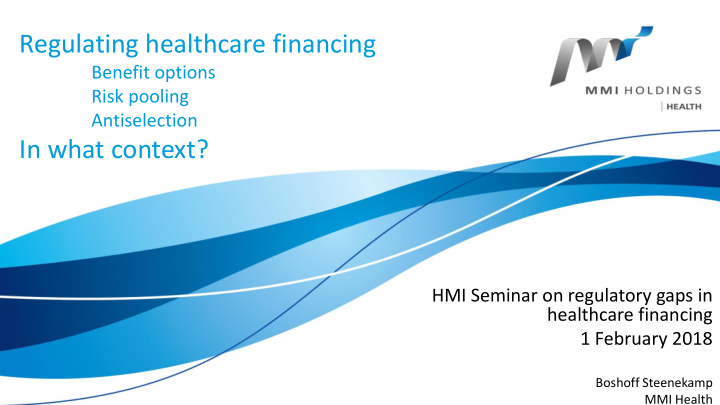



Regulating healthcare financing Benefit options Risk pooling Antiselection In what context? HMI Seminar on regulatory gaps in healthcare financing 1 February 2018 1 Boshoff Steenekamp MMI Health
Contents • Comments on the context of the proposed reforms • NHI White paper, MMI proposal, High level panel • For debate at NEDLAC during 2018, BUSA position is under development • Support for risk adjustment mechanism, mandatory membership, cautious about benefit option regulation 2
Universal health coverage is an old concept that was popularised by the 2010 World Health Report, and now enjoys world-wide attention UHC can never be fully achieved – the box keeps on growing. Does not imply a specific delivery system or financing mechanism. 3
Equity in healthcare financing Achievable through compulsion and cross subsidisation • Technical complexity requires specific skills to design a sustainable system • UHC is redistributive and therefore requires strong political leadership Health systems reform is path dependent World Health Organization. The world health report: Health systems financing: The path to universal coverage. Geneva : World Health Organization, 2010. Kutzin, Joseph, Yip, Winnie and Cashin, Cheryl. Alternative Financing Strategies for Universal Health Coverage. [ed.] Richard M Scheffle. World Scientific Handbook 4 of Global Health Economics and Public Policy. s.l. : World Scientific Publishing Company Pty Ltd, 2016, pp. 267-309.
NHI implementation structures Benefits for NHI Health technology assessment Health pricing Consolidation of financing National Health Commission Tertiary Health Services Human resources for Health 5
Many other structures are involved in the reforms 6
Envisaged system according to NHI White Paper • Publicly funded, Single Payer system • Purchaser provider split • General taxes initially. Payroll taxes, surcharges and VAT increases as economic growth allows • Medical schemes offer complementary cover • Comprehensive benefit package for all 7
Government Unemployed & Informally Small, medium & employees & Large employers uncovered employed micro enterprises parastatals 24 M 24 M 6 M Total population: 55 M Phase in mandatory membership Revenue collection Revised tax subsidy arrangements NHI fund Extended GEMS Existing medical schemes. Consider bargaining council schemes Pooling Establish NHI Fund, introduce risk equalisation for all pools, central fund may be a vehicle for government subsidies Alternate remuneration for NHI benefits, central negotiations for medicines, labs, consumables. FFS only for benefits above NHI package. Purchasing Phase in administration and purchasing by private third-party service providers Benefit Develop a single NHI benefit package for all South Africans Service delivery Public and private service providers, with revised team-based primary care and alternate health professional employment structures Introduce flexibility to support supply side reform through the creation of multidisciplinary teams, and current prohibition of employment Stewardship and oversight of health professionals Creating resources Private sector training of health professionals 8
Health system challenges Functions Intermediate Coverage objectives goals Creating resources Equity in resource Utilisation in Stewardship, governance, distribution relation to need Revenue collection oversight Financing Benefits Financial protection Pooling Efficiency and equity in finance Purchasing Transparency and Quality Service delivery accountability Steenekamp, Boshoff. Review of South African healthcare financing: towards Universal Health Coverage. A contribution towards the debate on achieving Universal Health Coverage in South Africa. Centurion, South Africa : MMI Health, 15 July 2016. McIntyre, Diane and Kutzin, Joseph. Health financing country diagnostic: a foundation for national strategy development. Health Systems Governance & Finance. Geneva : World 9 Health Organization, 2016. ISBN 978 92 4 151011 0.
Interventions towards UHC Service delivery, creating resources, stewardship, governance and oversight Revenue collection Pooling Purchasing Benefits Single health information platform Risk adjustment mechanism for medical schemes Virtual single risk pool Norms and standards for equitable financing in provinces Priority setting authority (NICE or HITAP) Coding, remuneration, and outcomes authority Transversal contracts for medicines, surgicals, labs and equipment Prepare for a purchaser provider split, improve service delivery State sponsorship for missing middle Stewardship, governance and oversight Creating resources Revenue collection Single health information platform 10 Based on: MMI Health. MMI Comments on NHI White Paper. Pretoria : MMI Holdings, 31 May 2016.
Relation between MMI proposal and OECD THE framework Supply side Demand side Public coordination • Provider payment • Cost sharing • Direct control on • Private insurance mechanisms pharmaceutical • Provider competition subsidies prices/profits • Insurer competition • Gatekeeping • (De)centralisation of health • Formularies and selective system functions • Definition of health • Sources of health system contracting • Generic substitution benefit package financing • Joint purchasing • Health technology • Workforce legislation assessment • Malpractice legislation Coding, remuneration, and outcomes authority • Budget caps Risk adjustment mechanism for medical schemes Priority setting authority (NICE or HITAP) Based on: Moreno-Serra, Rodrigo. The impact of cost-containment policies on health expenditure. [book auth.] OECD. Fiscal 11 Sustainability of Health Systems. Bridging Health and Finance Perspectives. Paris : OECD Publishing, 2015.
12 High Level Panel Report available at https://www.parliament.gov.za/high-level-panel
13 High Level Panel Report available at https://www.parliament.gov.za/high-level-panel
Common to each of the positions • Universality: Mandatory cover • Horisontal equity: Single fund, or virtual single fund through risk adjustments • Vertical equity: Public funding / subsidies / tax credits 14
Not addressed: Benefit option regulation • Lack of standardisation is perceived as a contributing factor to information asymmetry • Risk profile has a much larger impact than almost anything else! • Circular 8 experience: Low cost options would cross subsidise high claiming higher income members of higher cost options 15
Conclusion • Start working on a Risk adjustment mechanism, plan for different levels of risk adjustment for different benefit levels (Low cost benefit options, current package). Must use this as a mechanism to overcome the high level of inequity. Suggest a process. • Explore mechanisms for phasing in mandatory membership, consider income levels, employer sizes and other. Consider low cost benefit options. • Careful about benefit regulation, other interventions will make this less important: Tariffs, Risk Adjustment, Mandated risk bands, Outcomes Measurement, Health Technology Assessment, Appropriate benefit packages 16
Recommend
More recommend